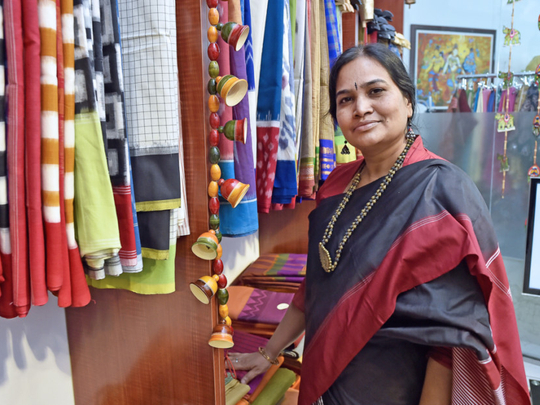
Dubai: The handloom sector in the state of Telangana is pulling its threads together again due to new incentives
Tradition often demands a price to be paid to keep it alive but sometimes, the cost can be too high for some. As the handloom industry in Telangana is challenged by industrial cloth mills and their cheaper imitations, traditional weavers, unable to cope with staggering loans and receding profits, are being driven to suicide.
But all is not lost yet, thanks to individuals such as Sudha Rani Mullapudi of Abhihaara, a social enterprise based in Telangana.
Telangana produces some of the finest cotton weaves in India and boasts of several handloom clusters.
The region is well known for its Gadwal, Pochampalli and Narayanpet saris, to name some.
A sector that once thrived in the region under the patronage of the erstwhile Kakatiya kings, the Nizams of Hyderabad and the zamindars, it is now severely compromised due to a host of factors: rising costs, decentralisation of pre-loom activities, cheaper imitation products from cloth industries, and the changing preferences of consumers enamoured by the cosmopolitan globalisation of fashion, Mullapudi told Gulf News, during a visit to a handloom exhibition in Dubai.
Earlier, the entire family was involved in the handloom weaving process, she said.
Subsequently, with the rise in population and increasing demand, master weavers entered the scene and thus began the exploitation. They began to keep the artisans under their control. With pre-loom activities such as spinning and dyeing being farmed out to others, the weavers slowly lost their grip on skills, negotiating power and direct connect with the market.
Where there’s dependency, there’s exploitation, Rani emphasised. It also did not help that the younger generations in the weaving community opted to seek jobs in bigger cities, moving away from their roots.
But thanks to the efforts of the Telangana government and intervention by corporate giants such as Microsoft and NGOs such as Oxfam, UNDP and Abhihaara, there’s a renewed initiative to revive the dying sector, said Mullapudi.
“Our aim is to connect women across the cotton supply chain — growers, weavers, garment makers and craft ar-tisans — so that all of them are at a mutual advantage,” she said.
The Telangana government, she said, has come up with several incentives such as yarn subsidies, loan waivers and separating hand looms from power looms. Also, all handloom clusters are geo-tagged to ensure end product genuineness.
Also helping the cause is social media. With a renewed emphasis on ethnic chic, the passion and interest in ac-tually visiting and buying directly from the weavers is on the rise, said Mullapudi. “Many people are going to Pochampally and Narayanpet to interact and see weavers at work. Slowly, the weaver-buyer connect is being revived,” she said.
Yet, damage cannot be entirely undone. “We have lost some of the finest weavers; had there been similar efforts about 10 years back, we would have saved them,” said Mullapudi.
Weavers:
Nalla Vijay (Saree in a match box)
Nalla Vijay from Siricilla wove a 5.48-metre sari that weighs just 60 grams and can fit in a match box. Vijay has taken after his late father Parandhamulu who created similar masterpieces. His latest feat was a silk saree that could pass through the eye of a big needle. But such skills are on the wane as handloom weaving dips as a pro-fession..
Mone Adilakshmi
Dudyala Shankar
An expert dyer who uses natural colours, Shankar, 48, from Koyyalagudem village of Yadadri district, weaves intricate ikat patterns. When incomes dwindled due to intermediaries, he tok up a job as an electrician. But ReWeave encouraged him to take up double ikats. He now earns Rs18,000 a month.
Shambhu Vaishali
She weaves the classic Narayanpet sarees, along with her husband, Krishna. Though ReWeave, the couple re-ceived working capital of Rs 40,000. They now earn Rs 9,000 a month and are able to educate their children. “Through UNDP’s Disha Project, we are [also] learning additional value-enhancing weaving skills,” said Shambhu.
Handlooms of Telangana
Pochampalli sarees:
Pochampally sarees from from Bhoodan in traditional geometric patterns of Ikat (right), enjoy an exalted status. In Ikat weaving, both warp and weft are dyed in intricate patterns and hand-woven. It takes about 15 days of continuous effort to make one saree.
Telia Rumal technique:
This form requires precision, patience and an elaborate understanding of the craft. The yarn is dipped in sheep dung overnight and then rolled, washed and treated in a solution of burnt castor seeds ash and water. Natural red and black dyes are used for Telia Rumal. Unless it is propagated more aggressively, it this heritage thread is in danger of being forgotten.
Gadwal:
This weave comes in the comfort of cotton and the elegance of silk. The cotton and silk warp is interlocked by twisting the fibres with ash. Not many artisans are left to practise this tradition.
Narayanpet:
Known for their affordability, Naranyanpet sarees are cool, lightweight cottons. At one time, were 2,000 artisans weaving them, but now their number is less than 300.
Gollabhamas of Siddipet:
Rich with milkmaid motifs, these sarees are now woven by only a handful of artisans. Telugu film actor Samantha Akkineni, handloom brand ambassador of Telangana, recently gifted one to Ivanka Trump on the latter’s visit to Hyderabad.












